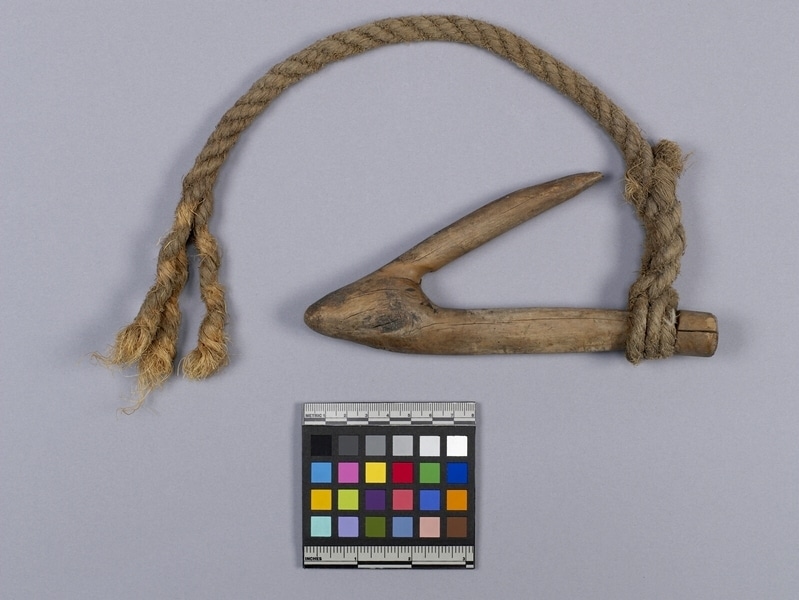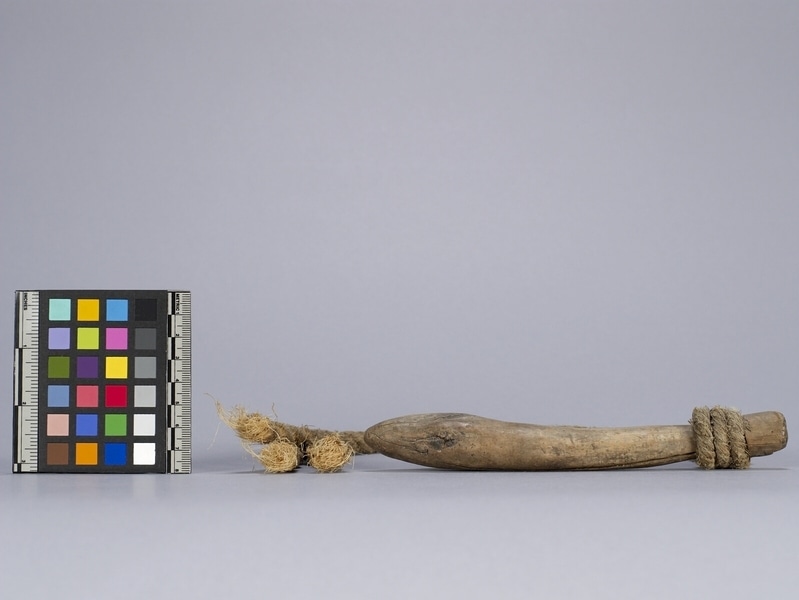Hook Item Number: Edz1096 from the MOA: University of British Columbia



Description
Large, v-shaped, barbed wooden hook with a short length of twined rope attached at the end.
History Of Use
After cutting a bundle of grass, the woman would wrap the rope around the bundle once, place her carrying pole on it, and wrap it again, pulling the role around the hook and tucking it in. She wrapped a thinner cord around the heads of the grass. She carried one bundle at each end of her pole, and carried it down from the mountain. After the mid-twentieth century the New Territories of Hong Kong began to undergo fundamental changes. The people who had been settled there before 1898, when the British colonizers claimed the area, began to give up rice agriculture and coastal fishing, turning instead to wage labour and increased employment overseas. By the end of the century, educational opportunities leading to the possibility of white-collar work also increased, together with western influences. These changes meant that objects and clothing once useful and appropriate were no longer needed and generally were discarded. Some were saved by their owners, who sometimes were willing to donate them to museums, sharing, also, their knowledge of how they were made and used.
Specific Techniques
The woman who needed the hook cut and shaped it from a natural branch. To make the rope, she grew hemp and then pulled it out of the ground and dried it. She removed the outer layer. On the first day of winter women worked in groups of three to make rope. One sat on a chair with a wheel, one passed the hemp fibre over, and the third fed it into the wheel. They made a strand about 20 feet long, and then twisted it in the middle and doubled it over, and did this again. To fasten it to the hook, it was raveled and rebraided.
Item History
- Made in Tsuen Wan, Hong Kong, China
- Collected by Elizabeth L. Johnson during 1979
- Owned by Elizabeth L. Johnson before March 17, 1980
- Received from Elizabeth L. Johnson (Seller) and Museum of Anthropology Shop Volunteers (Funding source) on March 17, 1980
What
- Name
- Hook
- Identification Number
- Edz1096
- Type of Item
- hook
- Material
- guava wood and hemp fibre
- Overall
- height 19.0 cm, width 9.5 cm, depth 2.5 cm
Who
- Culture
- Chinese: Hakka
- Field Collector
- Elizabeth L. Johnson
- Previous Owner
- Elizabeth L. Johnson
- Received from
- Elizabeth L. Johnson (Seller) and Museum of Anthropology Shop Volunteers (Funding source)
Where
- Holding Institution
- MOA: University of British Columbia
- Made in
- Tsuen Wan, Hong Kong, China
When
- Collection Date
- during 1979
- Ownership Date
- before March 17, 1980
- Acquisition Date
- on March 17, 1980
Other
- Condition
- good
- Accession Number
- 0610/0066